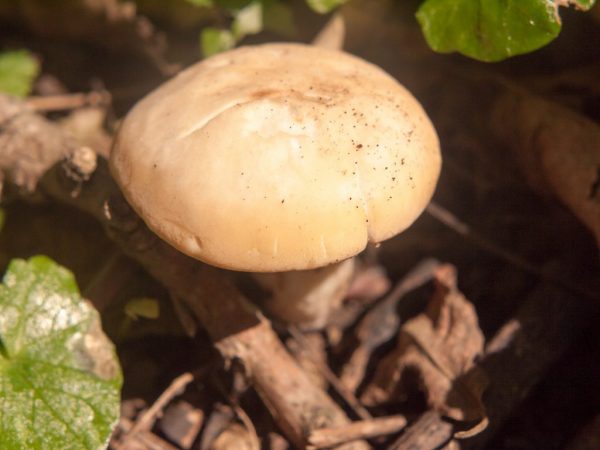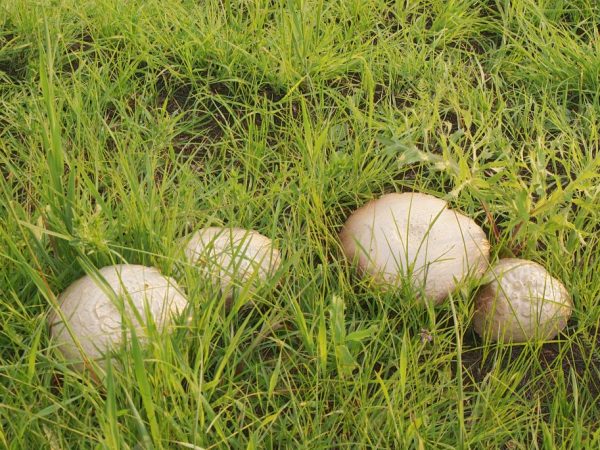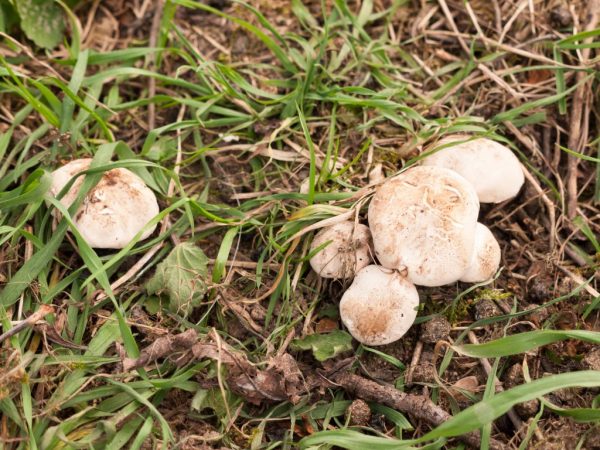Description of May mushroom
May mushroom belongs to the edible group. Its other names are kalotsibe and ryadovka May. You can collect it in different places: in fields, forests and even in sandy areas. For edible qualities, this variety is classified into 4 categories.

Description of May mushroom
Benefit and harm
May mushrooms have a number of beneficial properties:
- Get rid of cellulite. Potassium in its composition helps tissues to be elastic. Also, calocybe restores water-salt balance and normalizes blood circulation.
- The chemical composition has a positive effect on the health and functional characteristics of the thyroid gland. Help with goiter and hypothyroidism.
- They contribute to the acceleration of metabolism due to the content of fiber and water in the mushroom.
- Soothes, helps relieve stress. The product contains sugar, from the point of view of science - glucose, which has a beneficial effect on the brain and improves mood. Also, the mushroom tones up and relieves fatigue due to the riboflavin content.
- They contain ascorbic acid, which supports the immune system.
- Includes fiber to help cleanse the intestines.
- Improves heart function.
- Prevents cancer.
There are contraindications to the use of May mushrooms. They cannot be eaten:
- children under 3 years old;
- in the presence of diseases of the gastrointestinal tract.
Pregnant women can use this type of mushroom only in boiled or stewed form.
Description of the mushroom
The name "May mushroom" appeared because of the time when the first representatives of culture appear - the first days of May. Harvesting is carried out until the beginning of autumn. Eat both young and overripe calocybe. The disadvantage of the May mushroom is its tendency towards worminess.
Appearance
According to the description, the size of the May mushroom is large, but the height of the fruiting body is small. The cap gives the mushroom its massiveness. It is dense and thick, up to 12 cm in diameter. The hat rests on a thick low leg with a diameter of up to 3 cm, up to 7 cm long. The flesh at the leg is white, fleshy.
The top of juveniles is rounded, resembling a ball. Later, the cap opens and takes on a flat shape. The drier the climate, the more wrinkled the cap is, and it also becomes covered with cracks. The plates are thin, frequent. The color is uniform: white or cream.
The taste is full-bodied. Fresh mushrooms smell like ground flour.
Composition
May mushrooms are also characterized by low calorie content.
100 g of product contains 19 kcal. The composition of these very grams includes:
- ash substances - 2.7 g;
- fats - 0.7 g;
- water - more than 90 g;
- carbohydrates - 1.5 g;
- proteins - 1.7 g;
- dietary fiber - up to 3 g.
May mushroom contains B vitamins (B1, B2, B5, B6, B9), also: E, C, PP (NE), so it is useful for vitamin deficiency.
Irina Selyutina (Biologist):
Vitamin PP (niacin) is a group of vitamins that consist of two main components, firstly, nicotinic acid and secondly, nicotinamide. In the human body, niacin can be synthesized from the essential amino acid tryptophan. Studies have shown that 60 mg of tryptophan produces 1 mg of niacin.Therefore, the daily human need for this vitamin is expressed in niacin equivalents (NE). It means that 1 NE = 1 mg PP or 1 NE = 60 mg tryptophan.
It was found that the daily norm of PP for the normal functioning of the body of an adult depends on gender and is:
- for men: 16-28 mg;
- for women: 14-20 mg.
For children, the daily norm of niacin (6 mg / day) was also established, it should increase as he grows up and, somewhere around 18 years old, reach the level of an adult.
For your information. For pregnant women, 2 mg of niacin is added to the daily allowance, and for lactating women - 3 mg.
The product is rich in organic acids and contains 18 amino acids. There is also a specific set of trace elements for the species, including:
- iron;
- manganese;
- cobalt;
- fluorine.
Collection rules

Mushrooms can be found in meadows
May mushroom thrives on different types of soils, its main requirement is a sunny place. It is harvested in gardens, roadside, meadows and deciduous forests. It grows not only outside the city, but also on the territory of megalopolises or other settlements right in the flower beds. The collection of May mushroom is carried out in an ecologically clean place, because this culture, like other types of mushrooms, is capable of accumulating toxins from the external environment.
When the month is dry, the harvest is harvested until mid-summer. In September, the Kalocibe meets for the second time, in the same places, but (oh, this is "but") the number will be less. The hats of the second wave are already yellow.
In order not to confuse calocybe with other poisonous counterparts, they are sniffed. Toxic specimens smell of dampness and rot. This species is often confused with the poisonous enotomola, but they have a dark color and a thin stem.
Views
All types of mushrooms are divided into edible, conditionally edible, inedible and poisonous. Edibles include:
- crowded row;
- R. earthy gray;
- R. May;
- R. poplar;
- R. group;
- R. green.
Conditionally edible:
- the row is blushing;
- R. golden;
- R. separated;
- R. red-violet;
- R. greasy;
- R. armored;
- R. woolly.
Inedible:
- the row is soapy;
- R. sulfuric;
- R. white-brown;
- R. striped;
- R. spruce.
Poisonous:
- the row is spotty;
- R. leopard;
- R. twisted.
Cooking applications

Mushrooms taste good
May ryadovka tastes good and goes well with other products. Try to cook it using our recipes and you will try to find more of these mushrooms.
Mushroom yummy casserole
Required products:
- potatoes - 6 pcs.;
- carrots - 3 pcs.;
- fresh mushrooms - 200 g;
- sour cream (fat) –2 tbsp. l .;
- chicken egg - 1;
- salt, pepper - to taste;
- vegetable oil.
Vegetables and calocybe are peeled and finely chopped. In a separate bowl, mix until a homogeneous mass is formed. Next, the prepared mixture is salted, pepper, poured with an egg-sour cream mixture. Put in a double boiler (before that, grease with vegetable oil). Leave for 35 minutes setting the "Extinguishing" mode. Serve in portions, sprinkling each portion with hard cheese.
Calocybe soup
Required products for 2 liters of water:
- boiled mushrooms - 250 g;
- potatoes - 3 pcs.;
- carrots - 1 pc.;
- onion 1 pc .;
- salt, spices to taste;
- cereals or pasta - at your discretion;
- vegetable oil for frying.
Cut carrots and onions, fry. The same is done with mushrooms boiled in advance. The potatoes are peeled and diced. All vegetables are placed in boiling salted water. Either cereals or pasta are added. Spices to taste. Sprinkle with hard cheese when serving.
Stuffed tomatoes
Required products:
- large tomatoes - 7 pcs.;
- fresh mushrooms 300 g;
- carrots - 1 pc.;
- onion - 1 pc .;
- chicken egg 2 pcs.;
- sour cream (fatty) - to taste;
- garlic, salt, pepper - to taste.
Tomatoes are washed, cut off the "ass" and the pulp is removed with a spoon so as not to damage the walls of the fruit. Onions, carrots are washed, peeled and chopped. Calocybe is washed, cut and fried with onions and carrots. Chicken eggs are boiled, mixed with prepared vegetables and seasoned with sour cream. Garlic, salt, pepper are added to taste.
Kalotsibe with feta cheese
For cooking you will need:
- fresh mushrooms - 300 g;
- butter - 35 g;
- feta cheese - 150 g;
- chicken egg - 1 pc.;
- salt, pepper - to taste.
The mushrooms are washed, peeled and fried. Egg and feta cheese are added to them, left until cooked. The resulting appetizer goes well with potatoes.
Do not forget: the indicated amount of vegetables always means medium-sized vegetables.
Conclusion
The first May mushrooms are harvested from May to June. They have a small cap shape with a diameter of up to 12 cm. They are used ready-made, less often fresh. This dietary product is capable of removing toxins and toxins from the body, normalizing the work of the heart and gastrointestinal tract. Kalocybe grows in well-lit places. Any soil is suitable. Mushrooms can be found in deciduous forests, pastures and fields.



